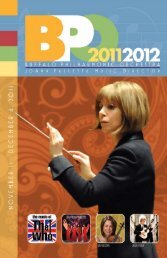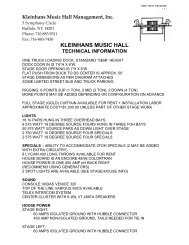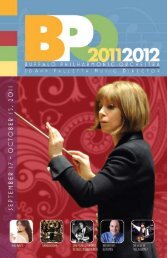Untitled - The Buffalo Philharmonic Orchestra
Untitled - The Buffalo Philharmonic Orchestra
Untitled - The Buffalo Philharmonic Orchestra
You also want an ePaper? Increase the reach of your titles
YUMPU automatically turns print PDFs into web optimized ePapers that Google loves.
<strong>Buffalo</strong> <strong>Philharmonic</strong> <strong>Orchestra</strong><br />
20<br />
the Romantic Age. We may be certain that<br />
Strauss also intended to serve as a parting<br />
valentine as well to his wife of fifty-five<br />
years, Pauline, who had had her own fine<br />
career as a soprano soloist.<br />
<strong>The</strong> Four Last Songs are a luxuriant trove<br />
of melody and probing harmonies - all in<br />
service to the evocative poetry of the solo<br />
voice, which lingers like soft sunlight over<br />
a mystic forest of orchestral tone.<br />
Alban Berg<br />
Austrian composer<br />
Born February 9, 1885, Vienna<br />
Died December 24, 1935, Vienna<br />
Sieben frühe Lieder -<br />
Seven Early Songs<br />
Nacht<br />
Schilflied<br />
Die Nachtigall<br />
Traumgekrönt<br />
Im Zimmer<br />
Liebesode<br />
Sommertge<br />
<strong>The</strong>se are the first performances of this work<br />
on the Classics series; duration 17 minutes<br />
Though he was immensely gifted, Alban Berg<br />
is known to the music world for just a handful<br />
of titles. <strong>The</strong>se include his operas Wozzek<br />
and Lulu (unfinished in full score), the Violin<br />
Concerto and Lyric Suite for orchestra, and<br />
just a few chamber pieces and song cycles,<br />
including his Seven Early Songs.<br />
Berg was the third of four children in an<br />
upper-class family in which cultural values<br />
were keen. Like his siblings, he received<br />
instruction from a governess, including<br />
lessons on the piano for which he revealed<br />
exceptional aptitude. He was also<br />
passionately drawn to literature, especially<br />
the verse of the German Late-Romantics.<br />
By his early teens Berg began to mix<br />
metaphors by setting his favorite verses to<br />
music. Without his knowledge, his family<br />
managed to get copies of a few of Berg’s<br />
songs (he had already composed about<br />
80) to the celebrated Arnold Schönberg<br />
who agreed at once to accept Berg as a<br />
composition student without a fee.<br />
For the young and idealistic Alban Berg,<br />
under Schönberg’s influence the world of<br />
music became vast domain of possibilities,<br />
i.e. where every note carried a harmonic<br />
universe unto its own. <strong>The</strong> ultimate result<br />
was that Wagner’s ‘music of the future’ had<br />
opened the door to ‘atonality’ - i.e. music<br />
without a key center. No more D major, no<br />
more B minor. In musician’s terms, no more<br />
tonic, nor dominant, no more leading<br />
tones nor modulation. Indeed, a revolution<br />
that seemed almost frightening to those<br />
who loved Bach, Tchaikovsky or Mahler.<br />
But there is a delightful catch to all this.<br />
‘Atonal’ - without a key center, does not<br />
mean ‘atunal’ - without a melody. In Berg,<br />
as in Schönberg and others of the era,<br />
there are themes and wonderful melodic<br />
lines everywhere - it is only the harmonies<br />
that are ‘atonal.’ However, we are a bit<br />
ahead of ourselves.<br />
Berg’s Seven Early Songs were composed<br />
between 1905 and 1908, revealing a<br />
composer who was indeed en route ‘to<br />
the future.’ <strong>Orchestra</strong>ted in 1928, the<br />
songs are replete with a wonderful lyrical<br />
sense, based on melodies and harmonies<br />
which reach to the chromatic cosmos, but<br />
remain ‘terra firma’ in tonal construction.<br />
But his imminent progression into the realm<br />
of atonality was surely hinted and glinted<br />
in the songs.<br />
We should also note the composer’s<br />
choice to ‘word-paint’ (a term from<br />
Renaissance art songs) with timbres and<br />
tempos, embellishing the songs with<br />
evocative orchestrations as savvy as any<br />
in all of music. While the same can be<br />
said for Strauss’ Four Last Songs, what is<br />
striking here is the reach of Berg’s abstract<br />
mix of lyrics and voice with a select<br />
palette of symphonic color, very closely<br />
allied to the meaning and rhythm of the<br />
original poetry. One might say the artistry<br />
of each setting belies the science behind<br />
their conception, in particular for a twentysomething<br />
composer in the first decade of






